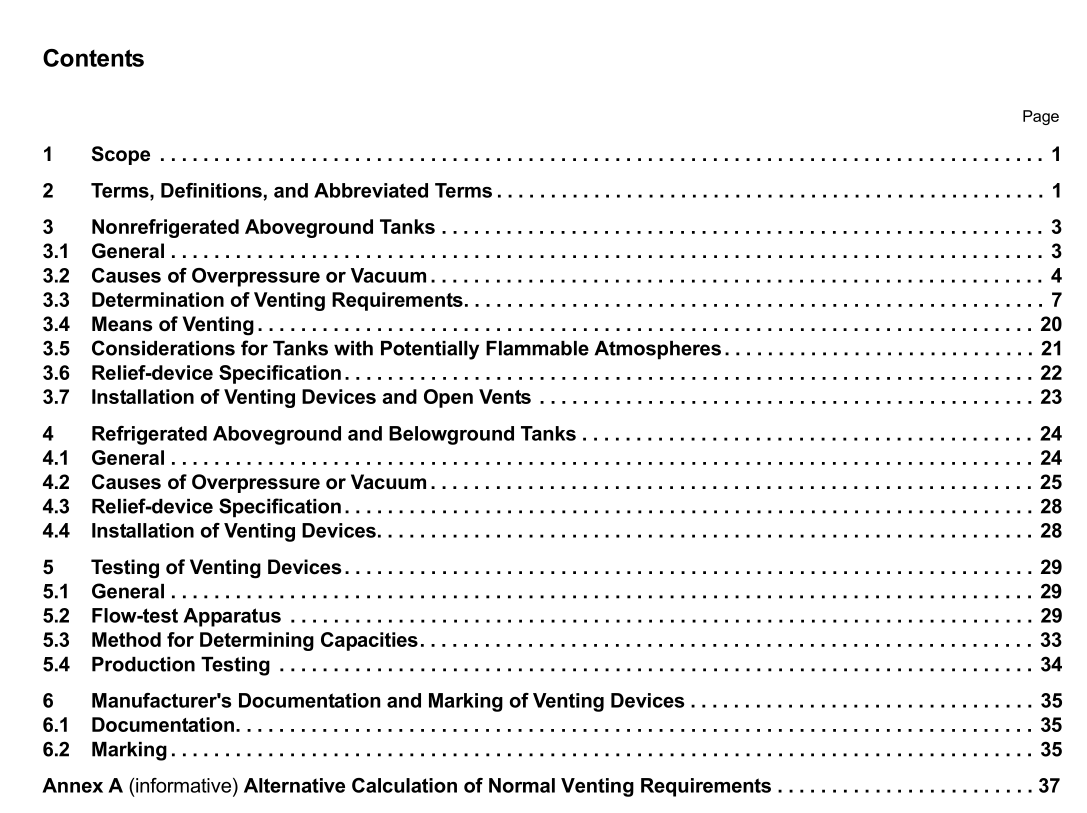API St 2000 pdf download

API St 2000 pdf download.Venting Atmospheric and Low-pressure Storage Tanks
1 Scope
This standard covers the normal and emergency vapor venting requirements for aboveground liquid petroleum or petroleum products storage tanks and aboveground and underground refrigerated storage tanks designed for operation at pressures from full vacuum through 103.4 kPa (ga) (15 psig). Discussed in this standard are the causes of overpressure and vacuum; determination of venting requirements; means of venting; selection and installation of venting devices; and testing and marking of relief devices. This standard is intended for tanks containing petroleum and petroleum products, but it can also be applied to tanks containing other liquids; however, it is necessary to use sound engineering analysis and judgment whenever this standard is applied to other liquids. This standard does not apply to external floating-roof tanks.
2 Terms, Definitions, and Abbreviated Terms
For the purposes of this document, the following terms, definitions, and abbreviated terms apply. 2.1 accumulation Pressure increase over the maximum allowable working pressure or design pressure of the vessel during discharge through the pressure-relief device. NOTE Accumulation is expressed in units of pressure or as a percentage of maximum allowable working pressure or design pressure. Maximum allowable accumulations are established by pressure-design codes for emergency operating and fire contingencies. 2.2 adjusted set pressure Inlet static pressure at which a pressure-relief valve is adjusted to open on the test stand. See set pressure (2.20). NOTE 1 Adjusted set pressure is equivalent to set pressure for direct-mounted end-of-line installations. NOTE 2 The adjusted set pressure includes corrections for service conditions of superimposed back-pressure. 2.3 British thermal unit Btu Unit of heat that increases the temperature of one pound of water by one degree Fahrenheit. 2.6 full open position Position where lift of the pallet is sufficient for the nozzle to control the flow or where the pallet or main valve seat lifts against a fixed stop. 2.7 nonrefrigerated tank Container that stores material in a liquid state without the aid of refrigeration, either by evaporation of the tank contents or by a circulating refrigeration system. NOTE Generally, the storage temperature is close to, or higher than, ambient temperature. 2.8 normal cubic meters per hour Nm 3 /h SI unit for volumetric flow rate of air or gas at a temperature of 0 °C and pressure of 101.3 kPa, expressed in cubic meters per hour. 2.9 normal venting Venting required because of operational requirements or atmospheric changes. 2.10 overpressure Pressure increase at the PV valve inlet above the set pressure, when the PV valve is relieving. NOTE 1 Overpressure is expressed in pressure units or as a percentage of the set pressure. NOTE 2 The value or magnitude of the overpressure is equal to the value or magnitude of the accumulation when the valve is set at the maximum allowable working pressure or design pressure and the inlet piping losses are zero. 2.11 petroleum Crude oil. 2.12 petroleum products Hydrocarbon materials or other products derived from crude oil. 2.13 PV valve Weight-loaded, pilot-operated, or spring-loaded pressure vacuum valve used to relieve excess pressure and/or vacuum that has developed in a tank. 2.14 rated relieving capacity Flow capacity of a relief device expressed in terms of air flow at standard or normal conditions at a designated pressure or vacuum. NOTE Rated relieving capacity is expressed in SCFH or Nm 3 /h. 2.15 refrigerated tank Container that stores liquid at a temperature below atmospheric temperature with or without the aid of refrigeration, either by evaporation of the tank contents or by a circulating refrigeration system.









